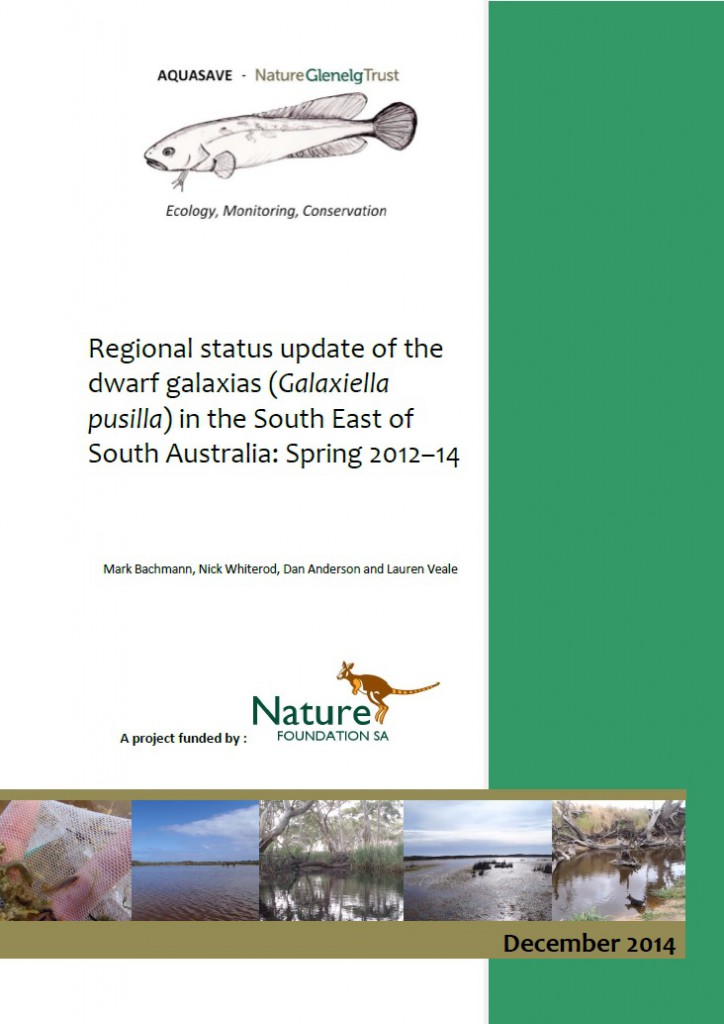A fresh look at the Dwarf Galaxias – or ‘Lap-lap’ (in Boandik language) – one of our region’s smallest native freshwater fish
It is great to be able to share the news that some work that started back in 2012, thanks to the generous support (in the form of a research grant) from the Nature Foundation SA Inc., has now been completed – with the finalisation of the NGT report summarising three years of spring surveys for the dwarf galaxias. You can download a full pdf version of the report here.
In some good news for the species, despite the severity and increasing intensity of the millenium drought towards the end of the last decade, the species has maintained a presence across the bulk of its previously described range in the South East – when compared to the last comprehensive survey undertaken by Michael Hammer during the drought back in 2008. It is also positive to see the role that restored wetlands are having in the species’ future conservation, with dwarf galaxias populations recorded from Pick Swamp (restored since 2007), Piccaninnie Ponds eastern wetland (restored since 2012), Middle Point Swamp (restored progressively since 2006), and Bucks Lake (which has had a restored flowpath in place from Lake Bonney now for several years). This, and the fact that wetland restoration benefits a much wider range of other species, is a great motivation for us to continue to look for opportunities to improve the hydrology (water regime) of modified wetlands across the NGT region in SA and Victoria.
This activity also helps us deal with one of the biggest threats to the dwarf galaxias, which is their fragmented, ‘relictual’ distribution (i.e. a fraction of what it used to be). We can be very confident that the species would have originally occurred much more extensively across the region based on their preferred habitats being widespread prior to the co-ordinated artificial drainage of the bulk of the region’s wetlands; an activity that commenced in the 1860’s.
In fact, there are a few interesting clues out there about just how widespread the species may have been, that can be found in early regional literature. A couple of interesting examples I have come across include the following:
A reference from near present day Robe by George French Angas in May 1844 (Savage Life and Scenes in Australia and New Zealand – published in 1847), page 155:
“… we crossed more spongy plains, covered with shells and tufa ‘biscuits,’ and subject to occasional inundations. On some of the swamps the natives had built weirs of mud, like a dam wall, extending across from side to side, for the purpose of taking the very small mucilaginous fishes that abound in the water when these swamps are flooded.“
and later near present day Southend, on page 174, when the exploration party (to which Angas belonged) came across an Aboriginal campsite:
“Before one fire were frying a quantity of very small mucilaginous fishes, which the natives catch in weirs upon the swamps and in the shallow waters of Lake Frome.“
Another interesting reference can be found in Julian Tenison Wood’s fantastic 1861 publication, Geological Observations in South Australia, on page 50:
“Some peculiarities of the swamps must yet be mentioned before this chapter concludes. As to their living inhabitants, their name is legion. A small fish is common to them all. Though often seen by me in the water, it has never received a closer examination. The bones of them may be found, from time to time, embedded in the mud. What is somewhat curious, these fish are found in small waterholes which have no connection with any running stream, and have been dry all the summer. The natives call the fish Lap-lap, and seem to be fond of them, though I have never seen any larger than about two inches long.“
The description of the fish occurring in isolated wetlands that might dry out through the summer is consistent with the biology of the dwarf galaxias, and (being an attribute unique to this species in our region) means that we can now share the original Boandik word for the dwarf galaxias: ‘lap-lap‘.
What an exciting thing to discover in a publication over 150 years old!



